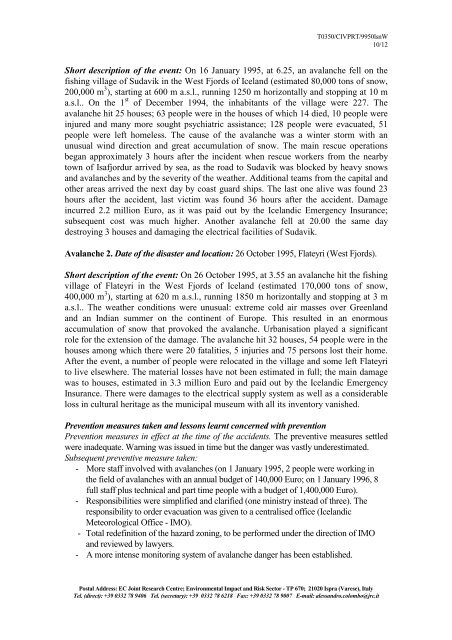lessons learnt from avalanche disasters - PreventionWeb
lessons learnt from avalanche disasters - PreventionWeb
lessons learnt from avalanche disasters - PreventionWeb
Create successful ePaper yourself
Turn your PDF publications into a flip-book with our unique Google optimized e-Paper software.
T0350/CIVPRT/9950lsnW<br />
10/12<br />
Short description of the event: On 16 January 1995, at 6.25, an <strong>avalanche</strong> fell on the<br />
fishing village of Sudavik in the West Fjords of Iceland (estimated 80,000 tons of snow,<br />
200,000 m 3 ), starting at 600 m a.s.l., running 1250 m horizontally and stopping at 10 m<br />
a.s.l.. On the 1 st of December 1994, the inhabitants of the village were 227. The<br />
<strong>avalanche</strong> hit 25 houses; 63 people were in the houses of which 14 died, 10 people were<br />
injured and many more sought psychiatric assistance; 128 people were evacuated, 51<br />
people were left homeless. The cause of the <strong>avalanche</strong> was a winter storm with an<br />
unusual wind direction and great accumulation of snow. The main rescue operations<br />
began approximately 3 hours after the incident when rescue workers <strong>from</strong> the nearby<br />
town of Isafjordur arrived by sea, as the road to Sudavik was blocked by heavy snows<br />
and <strong>avalanche</strong>s and by the severity of the weather. Additional teams <strong>from</strong> the capital and<br />
other areas arrived the next day by coast guard ships. The last one alive was found 23<br />
hours after the accident, last victim was found 36 hours after the accident. Damage<br />
incurred 2.2 million Euro, as it was paid out by the Icelandic Emergency Insurance;<br />
subsequent cost was much higher. Another <strong>avalanche</strong> fell at 20.00 the same day<br />
destroying 3 houses and damaging the electrical facilities of Sudavik.<br />
Avalanche 2. Date of the disaster and location: 26 October 1995, Flateyri (West Fjords).<br />
Short description of the event: On 26 October 1995, at 3.55 an <strong>avalanche</strong> hit the fishing<br />
village of Flateyri in the West Fjords of Iceland (estimated 170,000 tons of snow,<br />
400,000 m 3 ), starting at 620 m a.s.l., running 1850 m horizontally and stopping at 3 m<br />
a.s.l.. The weather conditions were unusual: extreme cold air masses over Greenland<br />
and an Indian summer on the continent of Europe. This resulted in an enormous<br />
accumulation of snow that provoked the <strong>avalanche</strong>. Urbanisation played a significant<br />
role for the extension of the damage. The <strong>avalanche</strong> hit 32 houses, 54 people were in the<br />
houses among which there were 20 fatalities, 5 injuries and 75 persons lost their home.<br />
After the event, a number of people were relocated in the village and some left Flateyri<br />
to live elsewhere. The material losses have not been estimated in full; the main damage<br />
was to houses, estimated in 3.3 million Euro and paid out by the Icelandic Emergency<br />
Insurance. There were damages to the electrical supply system as well as a considerable<br />
loss in cultural heritage as the municipal museum with all its inventory vanished.<br />
Prevention measures taken and <strong>lessons</strong> <strong>learnt</strong> concerned with prevention<br />
Prevention measures in effect at the time of the accidents. The preventive measures settled<br />
were inadequate. Warning was issued in time but the danger was vastly underestimated.<br />
Subsequent preventive measure taken:<br />
- More staff involved with <strong>avalanche</strong>s (on 1 January 1995, 2 people were working in<br />
the field of <strong>avalanche</strong>s with an annual budget of 140,000 Euro; on 1 January 1996, 8<br />
full staff plus technical and part time people with a budget of 1,400,000 Euro).<br />
- Responsibilities were simplified and clarified (one ministry instead of three). The<br />
responsibility to order evacuation was given to a centralised office (Icelandic<br />
Meteorological Office - IMO).<br />
- Total redefinition of the hazard zoning, to be performed under the direction of IMO<br />
and reviewed by lawyers.<br />
- A more intense monitoring system of <strong>avalanche</strong> danger has been established.<br />
Postal Address: EC Joint Research Centre; Environmental Impact and Risk Sector - TP 670; 21020 Ispra (Varese), Italy<br />
Tel. (direct): +39 0332 78 9406 Tel. (secretary): +39 0332 78 6218 Fax: +39 0332 78 9007 E-mail: alessandro.colombo@jrc.it












![View full document [PDF 988.55 KB] - PreventionWeb](https://img.yumpu.com/47733942/1/184x260/view-full-document-pdf-98855-kb-preventionweb.jpg?quality=85)
![View full document (in French) [PDF 4.96 MB] - PreventionWeb](https://img.yumpu.com/47223870/1/184x260/view-full-document-in-french-pdf-496-mb-preventionweb.jpg?quality=85)


![View full document [PDF 25.02 MB] - PreventionWeb](https://img.yumpu.com/44204570/1/190x234/view-full-document-pdf-2502-mb-preventionweb.jpg?quality=85)
